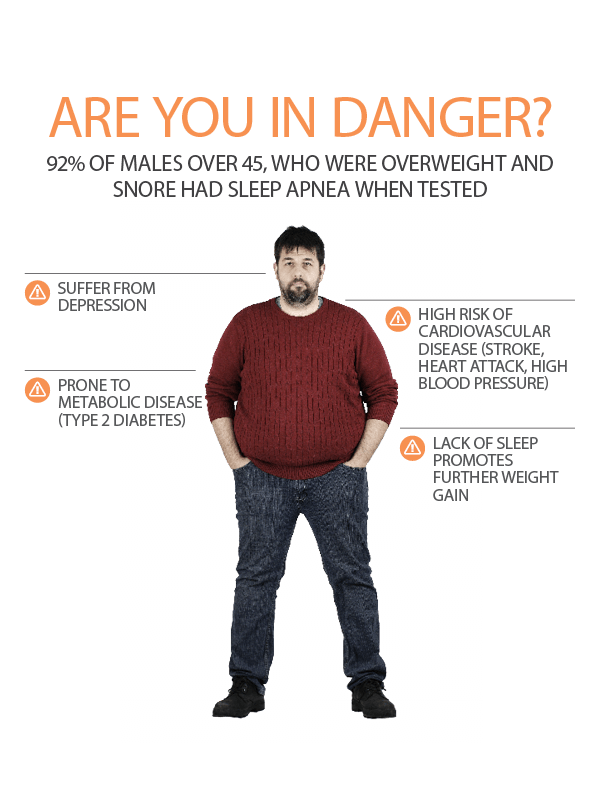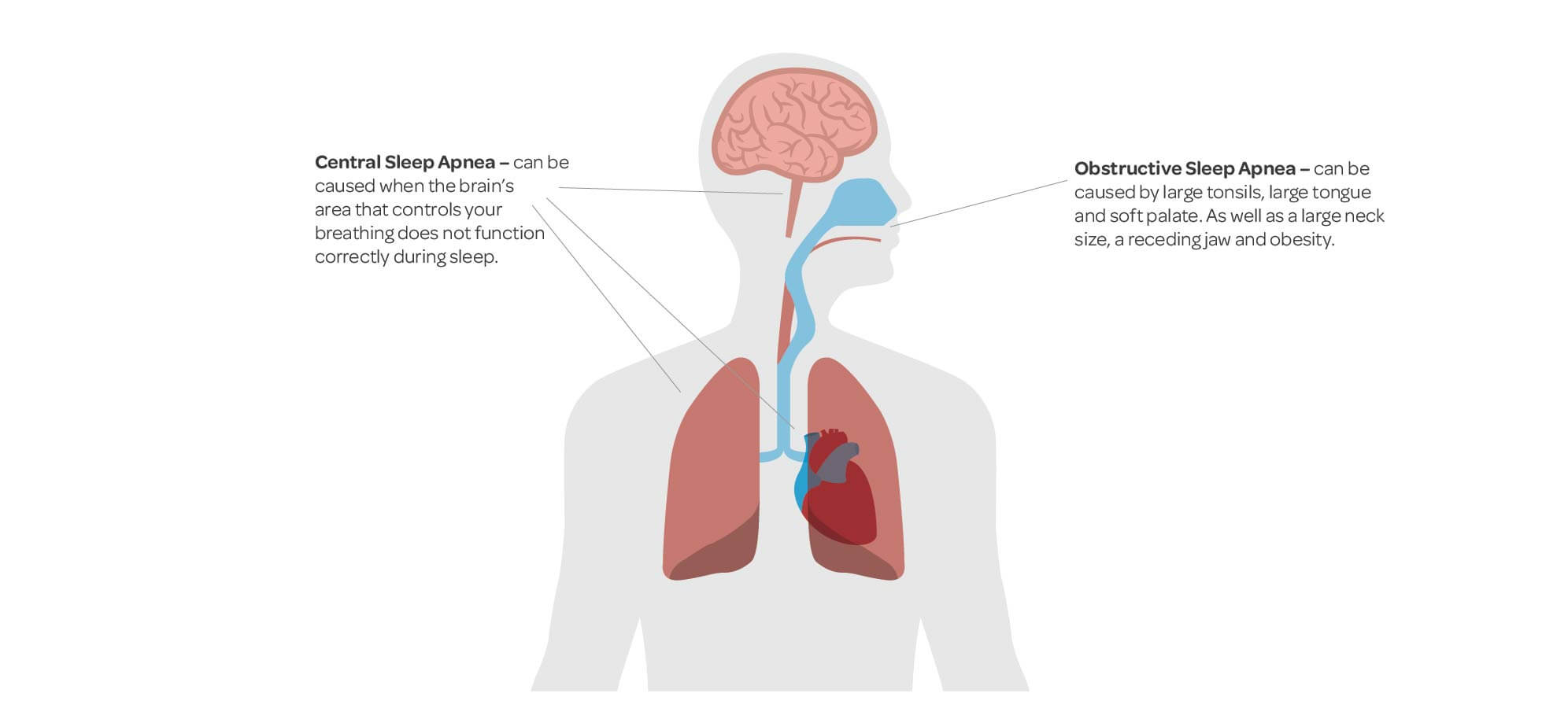SLEEP APNEA CAN BE A SERIOUS RISK TO YOUR QUALITY OF LIFE
WHAT IS SLEEP APNEA?
Sleep Apnea is not just snoring or feeling tired during the day – it is a serious medical condition. It not only affects your sleep but can severely impact your health and your quality of life.
The most common form of Sleep Apnea is called Obstructive Sleep Apnea (OSA). Obstructive Sleep Apnea occurs when the walls or muscles of the upper airway (including the tongue, soft palate etc) relax in such a way that they collapse and block the airway during sleep. The subsequent interruption of air supply to the lungs is called an apnea.
AN APNEA
An apnea can last up to a minute or more. In severe cases apneas may occur hundreds of times per night. During the apnea there is generally no sound which is particularly noticeable if the patient has been snoring previously. However, sometimes your partner may hear a choking noise.
Why are apneas harmful?
Apneas induce strong arousals which have severe effects on the body. During each interruption the oxygen circulating in the blood decreases as no new fresh air is able to replenish what has already been used by the body. This reduces the supply of oxygen to vital organs such as the brain and heart.
The brain soon realises there is a problem and that the body is struggling to breathe and trying to get air past the blockage.
The brain “wakes up” briefly to shock the cardiovascular system in order to clear the airway and start your airflow again. A sleeping partner may notice you moving in the bed and suddenly gasping for air. This cycle of breathing, then an apnea and then a sudden gasping for air can happen hundreds of times per night. The patient may not remember waking but your brain and body certainly start to feel the effects of these disturbances.
What are the harmful effects of having Sleep Apnea?
Effects of apneas include, disturbed sleep, increases in heart rate and blood pressure and changes to your body’s normal metabolic processes. If this is not rectified you may develop serious long-term medical problems such as hypertension and diabetes.
Find out more information on the health risks associated with Sleep Apnea.
Explore your Sleep Apnea Treatment options.

Based on a patient base of 78,145 across Australia, the Independent Sleep Physician Cohort (ISPC) shows how instances of Sleep Apnea can increase along with common risk factors. The patients in the sample were assessed for eligibility for a sleep test according to criteria set by the ISPC.
- Out of 78,145 patients tested, 86% of patients who were obese had sleep apnea, compared to 60% who were in a healthy weight range (BMI between 18.5 – 24.5).
- The chances of having sleep apnea also increased with other common risk factors:
- 84% of males tested had sleep apnea
- 88% of males, over 45 tested had sleep apnea
- 92% of males, over 45, who were overweight and obese had sleep apnea.1
WHAT HAPPENS IN SLEEP APNEA



Levels of sleep apnea
How many people have Sleep Apnea?
Obstructive Sleep Apnea (OSA) is the most common type of Sleep Apnea. 1 in 4 Australians suffer from this condition.3
The table shows the percentage of Australians who have the condition by age group. As you can see, it affects far more men than women.
| 45-55 years | 11% | 2.5% |
| 55 years and older | 24% | 6% |
Population by Age and Sex Aust States and Territories Jun 2005. Adapted from ABS 3201.1 Accessed 27/02/06
Different types of Sleep Apnea
In addition to Obstructive Sleep Apnea, there is also Central Sleep Apnea (CSA). This condition is uncommon and occurs in less than 10% of the number of people who present for a sleep test and around 1% of the total population.4
CENTRAL SLEEP APNEA
Unlike OSA, a patient with CSA stops breathing even though the airway is still open. The condition is caused by a malfunctioning in the brain’s respiratory centre which interferes with the signal that tells your body to breathe.
People with brain stem injuries such as stroke and brain tumours, those with chronic respiratory conditions or people with heart conditions such as congestive heart disease or atrial fibrillation are more at risk of developing CSA.
MIXED SLEEP APNEA
Mixed Sleep Apnea is even less common than CSA. It is a combination of both OSA and CSA. Usually, the CSA event occurs first that is then followed by an obstruction (OSA) in the airway.
Having any type of Sleep Apnea can cause a reduction of oxygen in the blood which alerts the brain and causes the person to wake. It is unlikely the person remembers this in the morning. The reduction in oxygen may also cause cardiovascular conditions such as high blood pressure and make it harder to control other conditions such as diabetes.
Get assessed, book online for a home sleep test.

References: 1. De-identified ISPC Patient Information (n=78,145) Data on file. 2. Buchner NJ, Sanner BM, Borgel J, Rump LC. Continuous positive airway pressure treatment of mild to moderate obstructive sleep apnea reduces cardiovascular risk. Am J Respir Crit Care Med. 2007 176:1274-80. Epub 2007 Aug 2. PubMed PMID: 17673692 3. Medical Services Advisory Committee, Public Summary Document, Application No. 1130 – Unattended Sleep Studies in the Diagnosis and Reassessment of Obstructive Sleep Apnoea March 2010. 4. Panossian LA, Avidan AY. Review of sleep disorders. Med Clin North Am. 2009 Mar. 93(2):407-25, ix.

